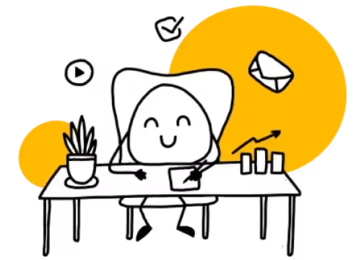.png)
Mental Health Strategies for Product Managers: Preventing Burnout
Practical, PM-specific mental health strategies for product managers: boundaries, rituals, stakeholder communication, and team culture. Read tips by PMs.

Why Mental Health Matters for Product Managers
Product management sits at the intersection of ambiguity, competing priorities, and distributed responsibility. That pressure is a reliable accelerant for stress and, when sustained, burnout. Because stress compounds at every stage of the product manager career path, learning mental health practices early helps prevent burnout later on.
What burnout looks like: chronic workplace stress resulting in exhaustion, cynicism, reduced efficacy. For PMs this often presents as constant cognitive fog, detachment from work outcomes, slipping judgment on prioritization, or chronic “hero-mode” firefighting.
Early signals to watch for: higher-than-normal anxiety at work, sleep problems, persistent irritability in meetings, decreased curiosity, declining quality of decisions, disrupted work-life balance, high mental exhaustion after work, or physical symptoms such as headaches and low energy.
Practical Daily Routines that Can Help PMs
These are specific, repeatable practices designed for the PM workflow — short, evidence-aligned, and tuned to real-world constraints.
1) Three-Thing Prioritization (3T) — Done Before Inbox
Every morning, before opening email, Slack, or Teams, list:
- 1 Priority (the single outcome that moves the product forward)
- 1 Blocking task (what, if unresolved, stalls progress)
- 1 Relationship task (a check-in, align, or a short async update)
Limiting to three keeps context-switching low, prevents the inbox from defining your day, and gives you one clear “win” indicator at day’s end.
2) Clean Up Your Calendar
Protect at least one 90–120 minute block of deep work per day for product thinking (roadmaps, specs, stakeholder synthesis). Treat it as non-negotiable: mark it busy and include an agenda line so meetings don’t encroach.
Also take time to cancel or shorten the meetings that haven’t been useful in weeks. PMs can often have recurring meetings that take a 45-min slot, but are only 20-30 minutes long. Sometimes two meetings with similar participants can be combined into one meeting with a longer agenda. Finally, if a meeting can be taken async, do it. Many less-important and operational meetings can be taken async and save time for everyone involved.
3) Message & Email Batching
Check your communication platforms (Slack, Teams, emails, etc) on scheduled cadences (e.g., 10:00, 1:00, 3:00). When possible, respond with short async updates and move resolution conversations to a request card or ticket, instead of an ongoing DM thread. This keeps you safe from constant email and messaging anxiety, and also helps you list down your resolved tasks.
4) Micro-Reset: 5–7 Minute Ritual Every 60–90 minutes
Stand, hydrate, and take 60–90 seconds for focused breathing or a quick walk. These micro-resets reduce decision fatigue and help you show up sharper for planning sessions or stakeholder conversations. At Product People, many PMs even block these short breaks in their calendars, a visible signal that this “me-time” is as non-negotiable as any meeting.
5) End-of-Day Shutdown Ritual (5 minutes)
Quick checklist: update the important people who need to know, move key decisions into a follow-up card for tomorrow, and set a hard Slack/Do-not-disturb status. Closing the loop protects your evening and sets clear expectation with your team about when you’re available, and when you’re not.
6) Weekly “Strategic Pause” (15–30 mins)
Book 15–30 minutes weekly for big-picture reflection (roadmap alignment, risks, capacity). Use it to re-evaluate priorities and avoid reactive mode. Make sure to also include your emotions in this strategic pause. What part of your responsibilities caused you and your team the most stress? How can you ensure this does not happen again?
Structural Fixes PMs Can Own or Influence
You don’t have to be the hiring manager to influence team systems. These changes scale — they reduce frequent stressors and prevent burnout across the org.
1) Make the “Bus Factor” Explicit and Solved
Propose a lightweight backup system for critical flows: ensure proper documentation so that everyone is on the same page and encourage other team members to run daily rituals. This reduces anxiety about single-person dependencies. Product People already has a successful system called the “Product People Trio”, which helps distribute the responsibilities and make our product management even better!
2) Design Sprints with Buffer Capacity
Prototype a sprint model with an explicit buffer (e.g., 10–15% capacity for unplanned work). Run it for a couple of sprints as an A/B test and measure overtime and defect rates. Unplanned work is often critical on top of the existing important sprint work. This puts additional strain not just on the developers and the designers, but on the product manager too.
3) Fixed Stakeholder Cadences + Async Default
Replace interrupt-driven updates with 1-2 weekly syncs and one async status. If you have multiple weekly stakeholder 1:1s with little to no value, combine them into one meeting with all the stakeholders (e.g., “Weekly Stakeholder Sync”). Furthermore, publish a one-line “how to request work” protocol so stakeholders know how to queue asks without immediate escalation and filling up your calendar.
4) Clear Escalation and Scope-Change Rules
One of the fastest paths to burnout for PMs is being forced to personally say “no” to every new request. Without a shared framework, every scope change feels like a conflict you have to carry on your shoulders. To solve this, define objective rules for escalation (e.g., “This change is over the 15% sprint capacity, so per our rules we’ll re-plan in the next stakeholder sync”). Make the rules public and track changes in your backlog so the process, not the PM, handles emotional labor.
Managing Stakeholders without Burning Out
Stakeholder pressure is the single biggest day-to-day stressor for PMs. These tactics make pressure visible and negotiable.
- Turn asks into compact request cards: objective, success criteria, impact, earliest delivery window, and required inputs. Ask stakeholders to confirm in one line. This converts urgency into a scannable contract.
- Public triage matrix: publish a simple Urgent/Important grid in your team wiki so priority decisions are shared artifacts.
- Escalation triggers: when a scope change meets your predefined threshold, escalate to a sponsor; don’t resolve scope tradeoffs solo.
- Delegate to process: where possible, route recurring requests into product ops or an intake queue so you aren’t the always-open channel.
Recognize, Prevent, and Recover from Burnout
Add these concrete actions to your toolkit, both for prevention and for if you or a teammate are already burning out.
Prevention (Ongoing)
- Normalize and model boundaries (scheduled time off, visible status changes).
- Reduce chronic context switching with protected deep work and fixed cadences.
- Track workload metrics (meeting hours, after-hours messages, pull-request lead time) and surface trends to your manager or people ops.
Early Intervention (Signs You Should Act Now)
- Reduced curiosity, frequent cynicism, or inability to complete small tasks.
- Physical symptoms (sleep disruption, appetite changes).
- Marked drop in decision quality.
If these appear: offload tactical tasks, book short recovery leave if necessary, and line up a handover (one-page) so the team can operate while you reset.
Recovery (if Burnout Has Occurred)
- Prioritize rest and a phased return: short days, clear handovers, and a temporary reduction in depth responsibilities.
- Rebuild predictability: schedule weekly check-ins about load, not deliverables.
- Document learnings: what stressors caused the burnout and what safeguards are needed going forward.
FAQ
Stop. Triage with the 3T (priority/blocker/relationship). Move at least one task off your plate (delegate, delay, or decline). Put a short DND and do a 10-minute reset. If workload is chronic, escalate to a manager and propose a measurable remedy (e.g., reduced meeting load for two sprints). Also, plan your time off in the near future, whether it’s a whole week off, or a couple of Fridays off in a month to help you recharge more.
Frame it as an experiment + metrics: propose a 6–8 week pilot (e.g., sprint buffer) with clear success metrics (reduced after-hours messages, fewer unplanned work items, improved sprint predictability).
High performance doesn’t mean overwork. It means designing sprints with buffer capacity, setting clear escalation rules, and making work predictable. Teams that respect mental health cues — like respecting focus time and limiting after-hours communication — sustain performance over the long term.
To reduce stress, shift from reactive messaging to structured updates. Use request cards to formalize asks, keep fixed stakeholder cadences, and document escalation thresholds. This removes the pressure of having to say “no” personally and protects your mental bandwidth.
Product culture is stronger when it values sustainable delivery over constant urgency. PMs can shape this by running “pressure post-mortems” after stressful projects, modeling healthy shutdown rituals, and reinforcing that focus and recovery are part of effective product work. It also ensures longevity in your product manager career path, allowing you to sustain leadership impact without burnout.
Read More Posts
.png)
Stakeholder Management Best Practices for Product Teams
.png)
Mastering Product Success: Designing for Seamless Adoption
.png)
Pricing Strategy Explained: The 4 Types & When to Use Each
.png)
The Power of Cost-Benefit Analysis for Product Teams
.png)
Navigating Client Requests: Opportunities in B2B
.png)


